|
|
|
Sort Order |
|
|
|
Items / Page
|
|
|
|
|
|
|
| Srl | Item |
| 1 |
ID:
113911
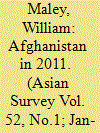

|
|
|
|
|
| Publication |
2012.
|
| Summary/Abstract |
Afghanistan confronted further turbulence in 2011, involving the assassinations of prominent figures, tense regional relations, and uncertainty about where the draw down of foreign forces in Afghanistan might lead. Popular confidence in Afghanistan's future direction remains weak, and President Hamid Karzai has had little success in boosting his government's standing.
|
|
|
|
|
|
|
|
|
|
|
|
|
|
|
|
| 2 |
ID:
180657
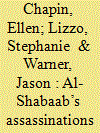

|
|
|
|
|
| Summary/Abstract |
In the study of terrorism, assassinations and suicide bombings have most commonly been considered as distinct phenomena. In practice, however, Al-Shabaab has shown a proclivity to use suicide bombings precisely as a means of assassination. But just how unique – if at all – is its use of suicide bombing assassinations (SBAs)? Using three unique databases on African suicide bombing combined with data from the Global Terrorism Database, this article seeks to understand the degree of uniqueness of Al-Shabaab’s SBA efforts from 2006 to 2020. In comparing Al-Shabaab to its nearest analogues – Boko Haram and Al-Qaeda in the Islamic Maghreb (AQIM) – across five different SBA metrics, this article demonstrates how Al-Shabaab is indeed rightly considered to be unique in its tendency to use suicide bombings as a tool for assassinations, at least on the African continent. It concludes by considering just what rationales underlie this proclivity, focusing on group-specific and environmental factors.
|
|
|
|
|
|
|
|
|
|
|
|
|
|
|
|
| 3 |
ID:
129267
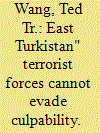

|
|
|
|
|
| Publication |
2012.
|
| Summary/Abstract |
Terrorism is a major hazard in today's world and poses an enormous threat to the international community's peace, security, and order. Over the years, especially since the 1990s, "East Turkistan" forces in and outside China have, for the purpose of establishing an "East Turkistan State," planned and organized a series of bombings, assassinations, arsons, poisonings, assaults, and other terrorist incidents that have taken place in China's Xinjiang and relevant countries, causing serious harm to the lives and property of China's various ethnic peoples and to social stability and posing a threat to peace and stability of the relevant countries and regions
|
|
|
|
|
|
|
|
|
|
|
|
|
|
|
|
| 4 |
ID:
123060
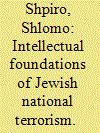

|
|
|
|
|
| Publication |
2013.
|
| Summary/Abstract |
The Lehi, a fringe Jewish paramilitary group created in 1940, conducted a concerted terrorist campaign against the British authorities in Palestine during and after World War II, proclaiming that its activities were undertaken in the name of national liberation. Lehi was founded and led by Avraham Stern, also known as "Yair." Scholar, intellectual, and poet, Stern developed a fundamental ideology of national and messianic Jewish terrorism, which became the ideological basis not only for the work of the Lehi, but also for later Jewish terrorist activism. The present article examines the intellectual foundations of Lehi terrorism and how its intellectual and ideological principles influenced Lehi's most controversial activities-internal terrorism and the execution of its own members. In conclusion, the author traces the impact of Stern's intellectual legacy on later generations of Jewish terrorists.
|
|
|
|
|
|
|
|
|
|
|
|
|
|
|
|
| 5 |
ID:
124921
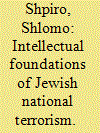

|
|
|
|
|
| Publication |
2013.
|
| Summary/Abstract |
The Lehi, a fringe Jewish paramilitary group created in 1940, conducted a concerted terrorist campaign against the British authorities in Palestine during and after World War II, proclaiming that its activities were undertaken in the name of national liberation. Lehi was founded and led by Avraham Stern, also known as "Yair." Scholar, intellectual, and poet, Stern developed a fundamental ideology of national and messianic Jewish terrorism, which became the ideological basis not only for the work of the Lehi, but also for later Jewish terrorist activism. The present article examines the intellectual foundations of Lehi terrorism and how its intellectual and ideological principles influenced Lehi's most controversial activities-internal terrorism and the execution of its own members. In conclusion, the author traces the impact of Stern's intellectual legacy on later generations of Jewish terrorists.
|
|
|
|
|
|
|
|
|
|
|
|
|
|
|
|
| 6 |
ID:
118256
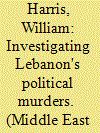

|
|
|
|
|
| Publication |
2013.
|
| Summary/Abstract |
This article reviews the investigation of Lebanon's 2004-2008 string of assassinations, a novel international venture precipitated by the February 2005 assassination of former prime minister Rafiq al-Hariri. It argues that shifting realist and idealist impulses on the international level, alongside a vicious struggle in Lebanon, allowed the intrusion of international justice in the form of the Special Tribunal for Lebanon (STL), although with meager results up to late 2012. The impact on Lebanon of the uprising in Syria against the Asad regime, a prime suspect in Lebanese assassinations, has both overshadowed the affair and raised the stakes involved in the STL's pursuit of it.
|
|
|
|
|
|
|
|
|
|
|
|
|
|
|
|
| 7 |
ID:
129428
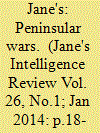

|
|
|
| 8 |
ID:
118612
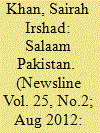

|
|
|
| 9 |
ID:
119497
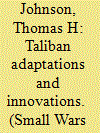

|
|
|
|
|
| Publication |
2013.
|
| Summary/Abstract |
Since 1978, insurgents in Afghanistan have endured a state of constant conflict, facing two occupying forces that have fielded modernized, highly capable militaries with a multitude of numerical and technological advantages over them. The asymmetry of these conflicts drove a rapid cycle of adaptation and innovation on the part of the insurgents that continues today. The Taliban way of war and approach to governance focuses on turning populations against political weakness and fielding simple and effective governance at the local and provincial levels. The Taliban has proven to be a highly adaptive, innovative, and resilient organization, drawing on tactics from conflicts in Iraq, Pakistan, and their own experience in Afghanistan to fight an effective and enduring defensive jihad. The introduction of improvised explosive devices, suicide bombers, and more recently a rising rate of assassinations all demonstrate the Taliban's ability to adapt tactically and innovate at the strategic level. These innovations are even more significant when one considers the cultural, social, and ideological barriers to change and how the Taliban overcame those barriers to include in their arsenal formerly taboo actions, such as suicide bombing. Understanding the innovation shown by insurgents in Afghanistan provides critical insights into the conflict the US-led coalition faces today and how it may be fought tomorrow.
|
|
|
|
|
|
|
|
|
|
|
|
|
|
|
|
| 10 |
ID:
154995
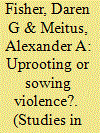

|
|
|
|
|
| Summary/Abstract |
Belligerent nonstate actors including terrorist organizations often exploit illicit economies to fund their activities. In Colombia numerous belligerent groups are involved in illegal narcotics markets. For more than 20 years, the Colombian government has responded with targeted eradication of illicit crops, intending to undermine the groups' sources of revenue while simultaneously disrupting the illicit drug economy. Despite its duration, this policy's effect on guerrilla violence remains unclear. Examining the potential for violent backlash to these tactics, this research note assesses the impact of aerial coca crop eradication in Colombia from 2004–2005 on domestic Colombian guerrilla kidnappings, assassinations, and terrorism.
|
|
|
|
|
|
|
|
|
|
|
|
|
|
|
|
|
|
|
|
|